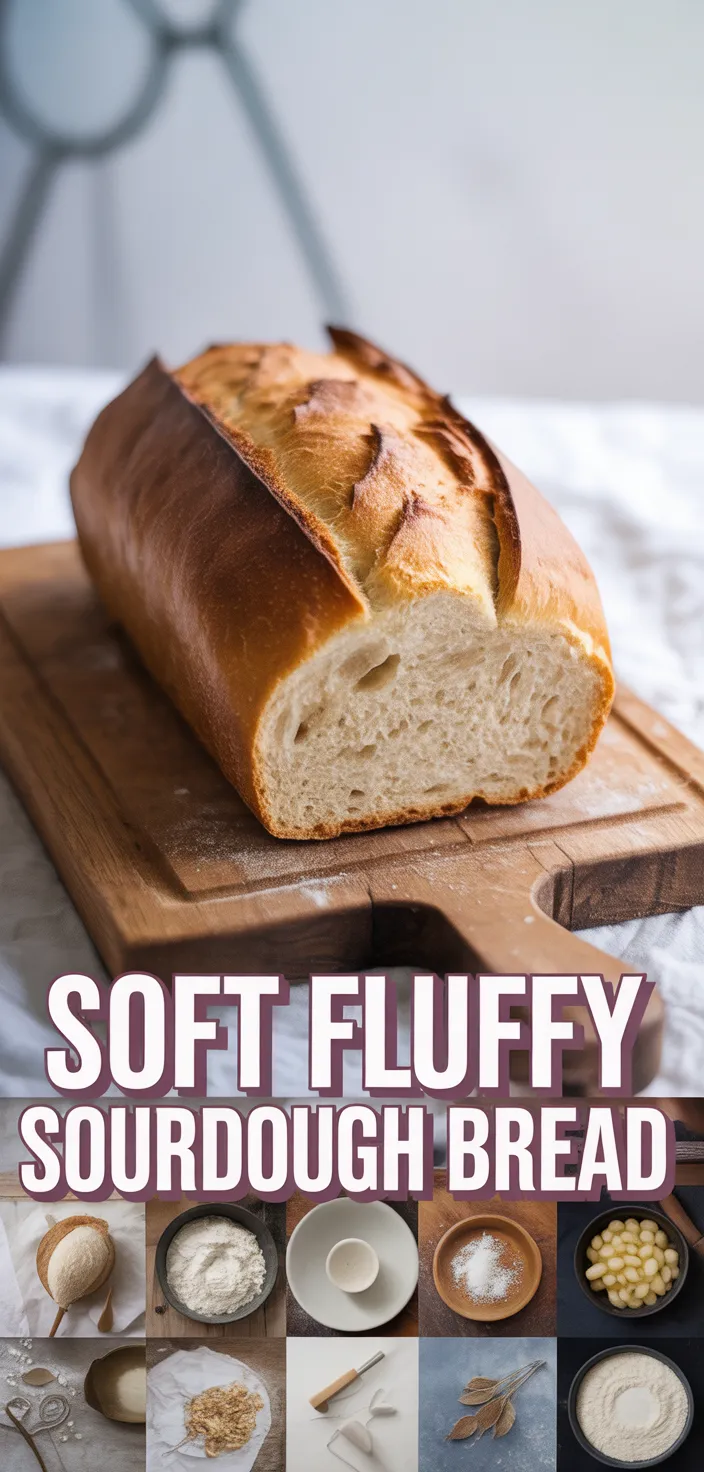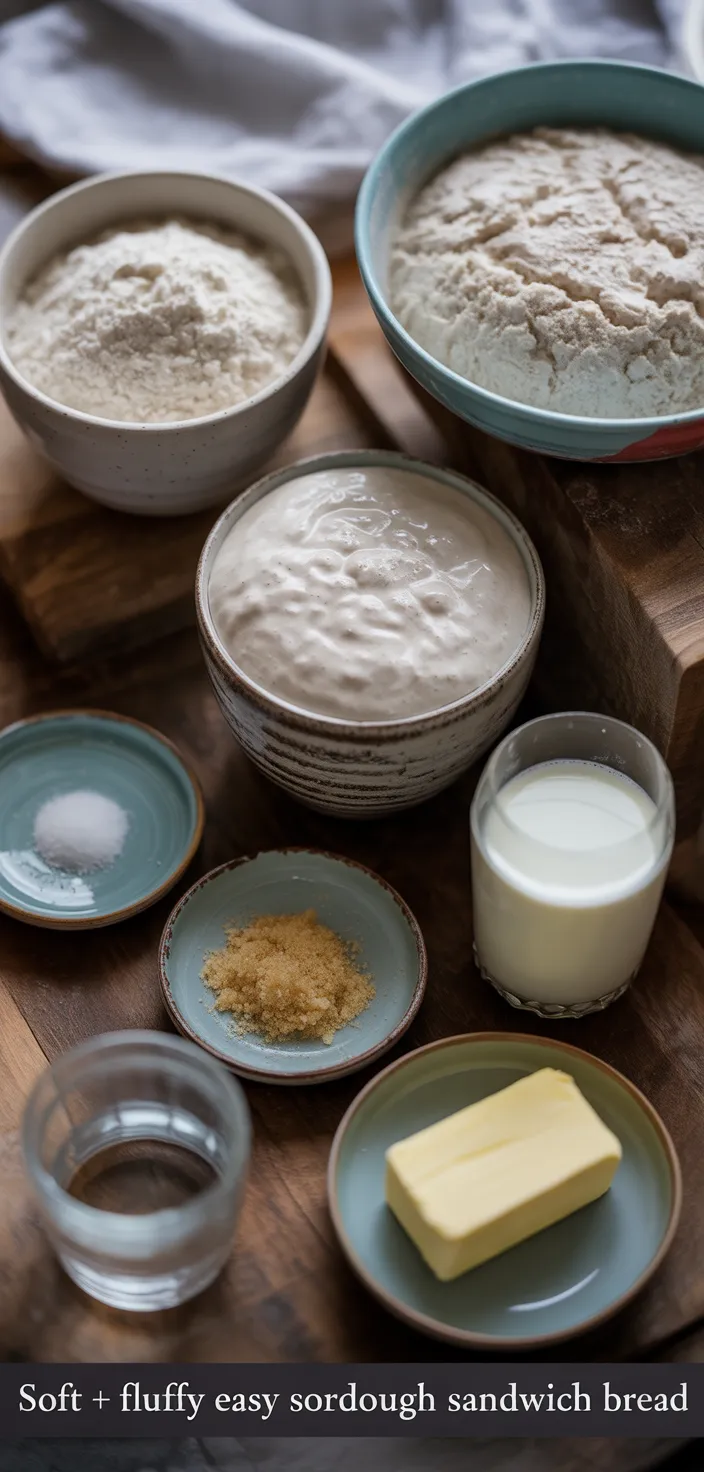I perfected my Simple Sourdough Sandwich Bread that turns a few pantry staples into an impossibly soft, fluffy loaf with minimal fuss.

I always thought sandwich bread had to be boring, until this Simple Sourdough Sandwich Bread surprised me. Using just bread flour and a bubbly active sourdough starter the loaf turns out soft and fluffy in a way that made me do a double take.
There’s a slight tang that pushes ordinary sandwiches into something interesting, and the crumb holds up without falling apart, which I didn’t expect. I messed up the first time, then kept tweaking, and now it feels like cheating how easy it is.
If you like bread that actually tastes like something youll want to try this.
Ingredients

- bread flour gives structure and chew, lots of protein for good gluten.
- whole wheat adds fiber and nuttiness, but can make loaf denser if used.
- starter brings tangy flavor and natural fermentation, helps rise and improves digestibility.
- milk makes crumb tender and rich, its adds fat and helps browning.
- sugar or honey sweetens slightly, feeds the starter and aids browning dont.
- butter adds softness and flavor, makes slices rich and keeps loaf moist.
- salt controls fermentation, enhances flavor and balances sweetness and tang.
- warm water helps hydrate dough and activates starter, but not too hot.
- brushing with milk or butter gives shiny crust and extra softness on top.
Ingredient Quantities
- 400 g bread flour
- 50 g whole wheat flour optional
- 100 g active sourdough starter 100% hydration fed and bubbly
- 200 g whole milk warm
- 45 g lukewarm water
- 9 g fine sea salt
- 25 g granulated sugar or honey
- 30 g unsalted butter softened
- Extra milk or butter for brushing the loaf optional
How to Make this
1. Make sure your 100 g starter is active and bubbly. In a bowl whisk the starter into 200 g warm whole milk and 45 g lukewarm water until smooth, then stir in 25 g sugar or honey so it dissolves. Warm but not hot liquid, please.
2. In a large bowl combine 400 g bread flour and the optional 50 g whole wheat flour. Pour the wet mix into the flour and stir with a spatula until a shaggy dough forms, no dry flour left. Let it sit for 30 minutes to autolyse.
3. After the autolyse add 9 g fine sea salt and 30 g softened unsalted butter. Work them in by folding and pinching, then knead by hand on a lightly floured surface or use a mixer with a dough hook until the dough is smooth and slightly tacky and can pass a weak windowpane, about 6 to 10 minutes.
4. Transfer dough to a lightly oiled bowl, cover. For the first
1.5 to 2 hours do 3 sets of stretch and folds every 30 minutes: reach under, stretch the dough up and fold over itself, rotate the bowl and repeat 4 times. This builds strength without heavy kneading.
5. After the last fold let the dough bulk ferment until puffy and slightly risen, about 1 to 2 more hours depending on room temp. It should feel airy, not flat. Don’t overproof it or the crumb gets gummy.
6. Turn the dough out onto a lightly floured surface, pre-shape into a loose loaf by folding edges to the center, rest 15 minutes uncovered. This relaxes the gluten so you can tighten the final shape.
7. Shape tightly to fit a greased 9×5 inch loaf pan, seam on the bottom. Smooth the top and place it seam side down in the pan so it will rise up, not out.
8. Final proof at room temperature until the dough puffs to about 1 to
1.5 times the pan height and a gentle poke springs back slowly, usually
1.5 to
2.5 hours. Or refrigerate overnight for an easier schedule and more flavor; if cold, let it warm 30 to 60 minutes before baking.
9. Preheat oven to 190 C / 375 F. Optionally brush the top with a little milk or melted butter for a soft crust. Bake on the middle rack for 30 to 40 minutes until deep golden and the internal temp is about 90 to 95 C (195 to 205 F). If it browns too fast, tent with foil.
10. Remove loaf from pan, brush with extra butter if you want a softer shiny crust, then cool on a rack at least 1 hour before slicing so the crumb sets. Enjoy, and don’t slice it too hot or it will be gummy.
Equipment Needed
1. Digital kitchen scale (grams)
2. Large mixing bowls
3. Whisk
4. Rubber spatula or spatula scraper
5. Bench or dough scraper
6. Stand mixer with dough hook (optional)
7. Clean towel or plastic wrap for covering
8. 9 x 5 inch loaf pan, greased
9. Instant read thermometer plus cooling rack and a pastry brush
FAQ
Soft + Fluffy Easy Sourdough Sandwich Bread Recipe Substitutions and Variations
- 400 g bread flour – If you don’t have bread flour, use 400 g all-purpose flour plus about 2 tablespoons (roughly 15-20 g) vital wheat gluten to bump the protein. It gives the chew and structure you want, otherwise the loaf will be a bit softer and less springy.
- 200 g whole milk (warm) – Swap with 200 g unsweetened soy or oat milk warmed the same way, or use 200 g water plus 25 g dry milk powder if you want the dairy richness without fresh milk. Texture stays close, flavor shifts slightly.
- 100 g active sourdough starter (100% hydration) – Replace with ~2 teaspoons (about 6 g) instant yeast mixed into the flour. Skip the long sourdough bulk ferment and proof for about 1 to 1.5 hours instead. You’ll lose the tangy sour flavor but the loaf will still be soft and fluffy.
- 30 g unsalted butter (softened) – Use 30 g neutral oil (canola, vegetable) or 30 g plant-based spread softened. Oil gives a tender crumb and keeps it moist, but the crust and flavor are a little different than butter.
Pro Tips
1. Weigh every ingredient, seriously, scales beat cups every time — you get consistent dough and fewer surprises. If you eyeball flour you’ll end up with a dense loaf more often than not.
2. Make sure the starter is lively and the liquids are warm but not hot. If your starter seems slow, feed it earlier or give it a warm nap so it’s bubbly when you mix, otherwise the rise will drag.
3. Don’t add salt or butter until after the autolyse, it really helps the gluten form with less work. If you use the whole wheat flour, expect the dough to feel stiffer and add a tiny bit more water or give it a longer rest so it hydrates fully.
4. When you do stretch and folds be gentle and deliberate, reach under, lift and fold rather than brute force kneading. Watch the dough more than the clock—look for smoothness and a slight windowpane not perfect strength, that stops you from overworking it.
5. Use the poke test and an instant read thermometer for the bake, and if you cold-proof overnight let it warm a bit before popping in the oven. If it browns too fast tent with foil, and brush warm butter right after baking for a soft shiny crust; also wait at least an hour before slicing so the crumb sets.
Soft + Fluffy Easy Sourdough Sandwich Bread Recipe
My favorite Soft + Fluffy Easy Sourdough Sandwich Bread Recipe
Equipment Needed:
1. Digital kitchen scale (grams)
2. Large mixing bowls
3. Whisk
4. Rubber spatula or spatula scraper
5. Bench or dough scraper
6. Stand mixer with dough hook (optional)
7. Clean towel or plastic wrap for covering
8. 9 x 5 inch loaf pan, greased
9. Instant read thermometer plus cooling rack and a pastry brush
Ingredients:
- 400 g bread flour
- 50 g whole wheat flour optional
- 100 g active sourdough starter 100% hydration fed and bubbly
- 200 g whole milk warm
- 45 g lukewarm water
- 9 g fine sea salt
- 25 g granulated sugar or honey
- 30 g unsalted butter softened
- Extra milk or butter for brushing the loaf optional
Instructions:
1. Make sure your 100 g starter is active and bubbly. In a bowl whisk the starter into 200 g warm whole milk and 45 g lukewarm water until smooth, then stir in 25 g sugar or honey so it dissolves. Warm but not hot liquid, please.
2. In a large bowl combine 400 g bread flour and the optional 50 g whole wheat flour. Pour the wet mix into the flour and stir with a spatula until a shaggy dough forms, no dry flour left. Let it sit for 30 minutes to autolyse.
3. After the autolyse add 9 g fine sea salt and 30 g softened unsalted butter. Work them in by folding and pinching, then knead by hand on a lightly floured surface or use a mixer with a dough hook until the dough is smooth and slightly tacky and can pass a weak windowpane, about 6 to 10 minutes.
4. Transfer dough to a lightly oiled bowl, cover. For the first
1.5 to 2 hours do 3 sets of stretch and folds every 30 minutes: reach under, stretch the dough up and fold over itself, rotate the bowl and repeat 4 times. This builds strength without heavy kneading.
5. After the last fold let the dough bulk ferment until puffy and slightly risen, about 1 to 2 more hours depending on room temp. It should feel airy, not flat. Don’t overproof it or the crumb gets gummy.
6. Turn the dough out onto a lightly floured surface, pre-shape into a loose loaf by folding edges to the center, rest 15 minutes uncovered. This relaxes the gluten so you can tighten the final shape.
7. Shape tightly to fit a greased 9×5 inch loaf pan, seam on the bottom. Smooth the top and place it seam side down in the pan so it will rise up, not out.
8. Final proof at room temperature until the dough puffs to about 1 to
1.5 times the pan height and a gentle poke springs back slowly, usually
1.5 to
2.5 hours. Or refrigerate overnight for an easier schedule and more flavor; if cold, let it warm 30 to 60 minutes before baking.
9. Preheat oven to 190 C / 375 F. Optionally brush the top with a little milk or melted butter for a soft crust. Bake on the middle rack for 30 to 40 minutes until deep golden and the internal temp is about 90 to 95 C (195 to 205 F). If it browns too fast, tent with foil.
10. Remove loaf from pan, brush with extra butter if you want a softer shiny crust, then cool on a rack at least 1 hour before slicing so the crumb sets. Enjoy, and don’t slice it too hot or it will be gummy.











